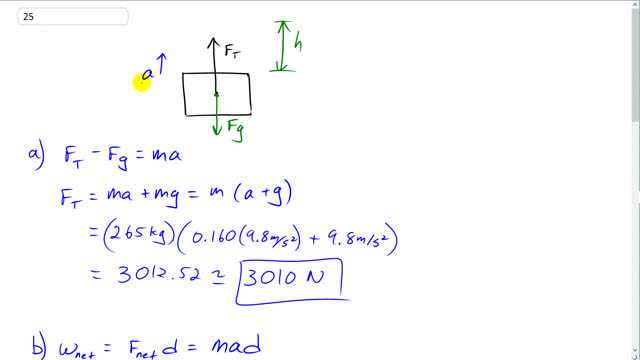
A 265-kg load is lifted 18.0 m vertically with an acceleration by a single cable. Determine
- the tension in the cable;
- the net work done on the load;
- the work done by the cable on the load;
- the work done by gravity on the load;
- the final speed of the load assuming it started from rest.

In order to watch this solution you need to have a subscription.
This is Giancoli Answers with Mr. Dychko. Here's a free-body diagram of this load with some tension force upwards exerted by a cable, some gravity down. It's accelerating upwards; it's an acceleration of 0.160 times g so times 9.8 meters per second squared there. And it's gonna go up this height, h, 18 meters. So, the tension in the cable we can figure out from Newton's second law, and we'll say the tension force up minus the gravity down has to equal the mass times acceleration; that force is always equal to ma. And we'll bring the gravity to the right hand side so it becomes plus and gravity's mg so it's plus mg then. So, the tension force is, factor out the mass times a plus g. So that's 265 kilograms times 0.16 times 9.8 meters per second squared that gives the acceleration upwards and then plus g of 9.8 meters per second squared which is a force of 3010 newtons. And the net work done on the load is the net force multiplied by the displacement so that's mass times acceleration times displacement. 265 kilograms times 0.16 times 9.8 meters per second squared times 18 meters that it goes up and that's 7480 joules of work done on the load net. The work done by the cable on the load is the force exerted by the cable on the load multiplied by displacement. And we figured out the force in part (a); that's 3012.52 newtons, before you round it, times 18 meters which is 54200 joules and that's positive because the cable force is the tension force and it's in the same direction as the displacement. The work done by gravity is gonna be negative mg times displacement because gravity is down whereas the displacement is up so they are in opposite directions and that is why we have a negative sign there. And the force of gravity is 265 kilograms times 9.8 newtons per kilogram times 18 meters and this gives us negative 46700 joules. And if you wanted to check your work, you can make sure that this minus this makes that, which it should. And then, the final speed we'll figure out from knowing that the change in kinetic energy is equal to the net work done and the net work is mass times acceleration times displacement. We already figured out the net work done and, but you know, instead of, using a number that we have already calculated, let's just carry on and we'll plug in numbers straight from the specified by the problem. So, we have one-half mv f squared because there's no initial speed so the change in kinetic energy is equal to the final kinetic energy here. And, we have mass times acceleration times displacement. And then, we'll multiply both sides by 2, divide both sides by m and then take the square root of both sides and the final speed is square root 2 times 0.16 times 9.8 meters per second squared times 18 meters—displacement—which is 7.51 meters per second, final speed.
When a question doesn't specify an initial speed we can assume it's 0? I'm used to seeing them specify "starting from rest". This is only true with an initial speed of 0.
Hi idan, thank you for the question. When a question doesn't specify an initial speed, and doesn't imply it by saying something like "lifted off the ground" or saying something else which could be interpreted as an initial speed, then you really don't know what the initial speed is. You can't assume it is zero. In this question, the initial speed doesn't actually matter until you get to part e) where it's asking for the final speed. In part e) it finally says "it started from rest". For parts a) through d), the force needed to impart an acceleration of is the same regardless of what speed it's going initially. Only the acceleration is relevant. For example, consider that the force needed to keep the load at rest would be the same as the force needed to make the load rise at a constant speed. The constant speed doesn't matter so far as the force is concerned.
Hope this helps,
Mr. Dychko